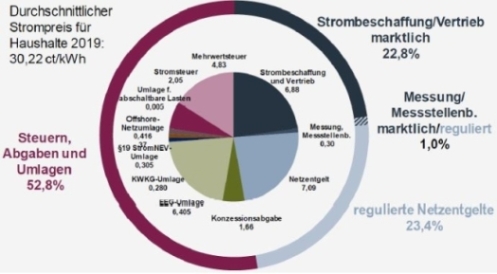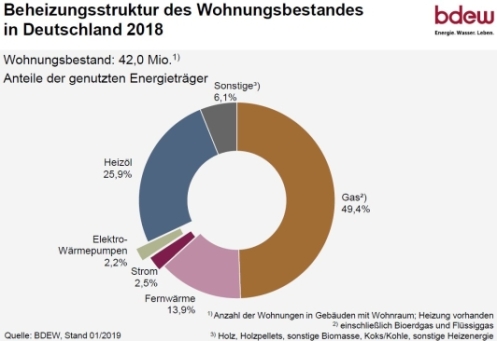Why Germans won’t heat their homes even with free electricity?
This is a translation/guest post by Riku Merikoski. The original can be found here (in Finnish). All mistakes due to translation are my fault.
On Monday 10th February 2020 something historical happened. For the first time, the market price of electricity fell below zero in Finland. While -0.2 € per megawatt hour (or -0.02 cents / kWh) is not dramatically different from earlier lows of 0.1 €/MWh, going negative is a strong symptom of the sickness that ails our electricity markets. Governments have created a situation where it is not worthwhile to use low carbon electricity even if it is free from time to time.
There are several reasons for the negative prices, but the main driver is the reckless support-policy for renewable electricity in Germany and Denmark.
In 2017 the total subsidies paid for renewable electricity in Germany were around 26 billion euros, of which 8.5 billion was paid to wind producers. Most of the wind production in Germany gets high feed-in-tariffs regardless of the market price of electricity. Only turbines built in 2016 or later take even a small hit to their revenues if prices go below zero, and more than 75 % of the production capacity was built before that.
As a result, Germany and Denmark have experienced negative prices already for years, and this time they remained negative for six hours. Strong imports from Denmark and Germany during the night were among the main causes for pushing Finnish prices below zero.
Germany had around 104 TWh of wind production in 2017. Divided to that amount, the 8.5 billion euros in tariffs means a tariff of around 82 €/MWh. Just a few years ago, new wind projects got a higher tariff of around 80 €/MWh for the first five years, and a lowered tariff for the next 15 years, which is most of their practical operational lifetime. Offshore wind had even higher tariffs, which increases the average wind tariff further. You can find out more about these numbers from the Bundesnetzagentur statistics.
Average onshore tariff is around 66 €/MWh and offshore tariff average is 159 €/MWh. There has not been much new onshore wind coming online during the last two years and just 2,000 MW of offshore wind, so the averages have not changed that much since 2017. The production for this day (10th February) was estimated to be around 40,000 MWh/h on average, meaning that almost 1,000,000 MWh of wind electricity was produced during the 24 hours. This means that roughly 80 million euros of wind tariffs were paid. On top of this, solar PV and bioenergy also got paid some tariffs, but during a windy winter day those are usually smaller amounts.
So is 80 million euros a lot or not? It’s a lot. The average market price for electricity in Germany was 8 €/MWh and total demand was around 1,500,000 MWh (1.5 TWh). During daytime electricity demand is higher and so is the market price, so the total market price for the 24 hours is roughly 15 million euros. The value of the wind production of around 1,000,000 MWh was roughly 8 million euros. The sources for all these numbers are from EEX and Entso-E.
Let’s take a moment to contemplate the numbers once more:
German electricity consumers paid 80 million euros in tariffs to get 8 million euros worth of wind power to the market. The total value of all electricity consumed in that day was 15 million €.
Broken Market
It is abundantly clear that this kind of subsidies will break the electricity markets. There is simply no point to make any market-driven investments in Germany; the tariffs are simply too large compared to the market value of electricity. While this single day was a very windy one, even the annual situation is bleak, as the tariffs paid for renewable electricity are of similar cost as is the total market value of all electricity consumed in Germany in that day. The Danish have a similar situation, but of course in a much smaller scale. Due to many interconnections between countries, what happens in Germany affects pretty much all of Europe to a degree.
What is the problem, isn’t free electricity great?
The first problem with “free” electricity is that nobody will invest in such a heavily subsidised market. The politicians have chosen the “winners” and everything else is a loser. Indeed, it is likely that without further subsidies in Finland, Sweden and Norway, there might have been not much investments in domestic wind capacity because the market was already getting saturated by Germany and Denmark and there were no signals coming from the markets. This might not be a problem if “getting more renewables” is the end-goal one prefers, but I think the goal should be decreasing emissions.
And here lies the second problem. The electricity taxation system we have is incompatible with this new normal where we have even negative prices from time to time. We tax the use of electricity the same way no matter what the price or CO2-emissions content of electricity is. The tax stays the same when electricity price is -10 €/MWh and its low carbon and when the price is 100 €/MWh and its high carbon.
This makes no sense, and the German system is the climax of this kind of dysfunctional policy. Why? Because the feed-in-tariffs for renewable energy in Germany are funded with additional taxes and fees collected from households and other smaller consumers from the electricity they consume. This leads to a situation where electricity costs 300 €/MWh (30 c/kWh) for these consumers on average. Image 1 below shows how this price is formed. A bit over fifth of the total cost is the cost of the energy (Strombeschaffung). About a quarter is transfer fees (Netzentgelte), and more than half is different taxes. Only the value-added tax (Mehrwertsteuer) is in any way relative to the price of electricity. The largest tax/fee is the EEG (EEG-Umlage) that is used to pay for the tariffs of renewable electricity, and then there is the electricity-tax (Stromsteuer) and a variety of other sorts of additional fees.

Image 1. The cost components of German household electricity. Source: Fraunhofer ISE, Recent facts about photovoltaics in Germany
We can also calculate the cost of electricity use for a German household when the price of electricity in the market is 0 €/MWh. After the other taxes and fees, the total cost is around 200 €/MWh (20 c/kWh). So even “free” electricity is almost as costly in Germany as the total average cost of electricity for households is in Europe, which is around 216 €/MWh (1st half of 2019).
Decarbonization of energy is done through electrification
It is a well-known fact that we need to electrify our use of energy, or in other words, replace burning of fuels with clean electricity, if we are to decarbonize our energy systems. And here lies the final problem. Germany taxes natural gas very lightly. Natural gas costs a household in Berlin about 62 €/MWh (6.2 c/kWh), as Household Energy Price Index tells us. This deserves another deep contemplation:
Even if a German household had a heat-pump installed with a COP of 3 (meaning one kWh of electricity is used to create 3 kWh of heat), and even if the market cost of electricity was free, the German household would be economically better off burning natural gas for heating.
And this dynamic can clearly be seen from image 2 below on how German houses are heated. Half of households are heated with natural gas and a quarter with fuel oil (Heizöl). Around 14 % are heated with district heating (Fernwärme), while electricity and heat pumps have a share of less than 5 %. And this is not due to old houses being heated with oil and gas. In 2019, the most popular heating method in new houses was still natural gas, and its popularity is still growing.

Image 2. Heating sources of German houses. Source: BDEW.
It is now the year 2020, and Germany has not even started to decarbonize their building heating. What is worse, as we learned above, the German tax-policy not only does not support this decarbonization of heating, but actively discourages it. Even “free” electricity is much too expensive for Germans to use for space heating because how electricity is taxed. If Germany wants to decarbonize its heating sector, this needs to change.
A first step would be to fix electricity taxation so that “free” electricity would be much lower cost for households than it is today, as when this happens, there is usually an oversupply of wind or solar and the electricity grid is somewhat clean (although Germany’s coal-plants often keep operating as it is too expensive to ramp them down just for a couple hours). This would also create additional demand for those low-cost periods which would increase the prices a bit and fix the broken market a little bit.
So far, there is no indications that anything would be done to fix this situation. It is my prognosis that Germany will fail to decarbonize its heating sector, which will likely mean that it will also miss its wider emissions reductions goals.
Author: Riku Merikoski
Translation: Rauli Partanen
Trackbacks & Pingbacks
- New top story on Hacker News: Why Germans won’t heat their homes even with free electricity? – Hckr News
- New top story on Hacker News: Why Germans won’t heat their homes even with free electricity? – protipsss
- New top story on Hacker News: Why Germans won’t heat their homes even with free electricity? – Ultimate News
- New top story on Hacker News: Why Germans won’t heat their homes even with free electricity? – The Pakistani News Corner
- New top story on Hacker News: Why Germans won’t heat their homes even with free electricity? – Latest news
- Why Germans won’t heat their homes even with free electricity? – INDIA NEWS
- Why Germans won’t heat their homes even with free electricity? – Hacker News Robot
- New top story on Hacker News: Why Germans won’t heat their homes even with free electricity? – News about world
- Why Germans won’t heat their homes even with free electricity? - Proxap
- Why Germans won’t heat their homes even with free electricity? — Economicon
- Top story HACKER NEWS: Why Germans won’t heat their homes even with free electricity? - Nate's Blog
- Why Germans won’t heat their homes even with free electricity? - Lapcity
- Start Up No.1250: a drug dealer’s lost bitcoin fortune, AI finds new antibiotic, on being cancelled, Germany’s wonky renewable incentives, and more | The Overspill: when there's more that I want to say
- Why Germans won’t heat their homes even with free electricity? | Evocatively Ambiguous







Thank you for your translation, I get the sense though that there may be a bit of a translation mistake when you use “tariff” for what sounds like should be “subsidies” instead. Tariffs are fees added on import/export of goods, subsidies are support of things that the government is usually trying to advance and usually comes in the form of financial backing. Your description of the situation fits more with the concept of subsidies.
Again, I immensely appreciate your translation of this perspective, because the distortion caused by government mucking around is particularly interesting to me. Especially in a time where we see ever more distortion of markets due to government central planning nonsense.
Thanks Dan. Yeah, it should be either subsidy or feed-in-tariff (which is one form of subsidy).